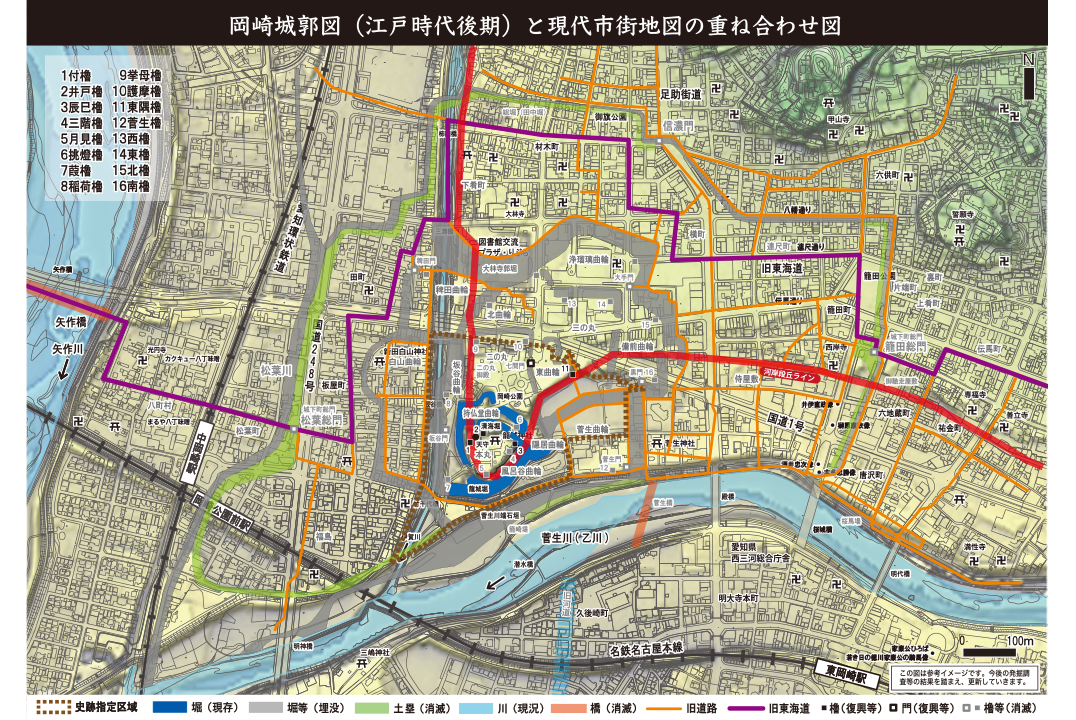Renjaku-cho area and Tokaido Highway Okazaki Castle Town 27 Turns

The Origins of Renjaku-cho
Renjaku-cho was a hamlet situated on the banks of the Sugou River (current Oto River). It was established around 1530-1535 when Tokugawa Ieyasu’s grandfather, Matsudaira Kiyoyasu, was lord of Okazaki Castle. The area was named Renjaku after the produce baskets carried on the backs of the many traveling merchants who gathered. Tax exemptions were offered to the merchants selling here, and this encouraged merchants from afar to come to Okazaki, further enlivening the town. The merchants were also entrusted with the protection of the castle gates during Ieyasu’s absence. As part of their duties, certain merchants were even allowed within the castle confines. During the Edo period, town officials were chosen from among the areas 19 villages, including representatives from Renjaku-cho.The main street, called Renjaku-dori, was a bustling commercial center about 440m long from east to west, and about 5m wide. It was lined with retail residences facing the street, which mainly sold daily necessities and supplies for samurai families, including sake, oil, cereals, and cotton. Despite the castle being decommissioned in 1873, the Renjaku area continued to prosper.
Maintenance of The Tokaido Route, Okazaki Castle Town’s 27 Turns
Between 1590 and 1600, Tanaka Yoshimasa served as the castellan of Okazaki Castle and undertook castle town improvement works. The Tokaido highway that passed through Myoudai-ji village on the southern banks of the Sugou River (now the Oto River) was redirected to within the castle grounds, and outer defenses were built, further enclosing the castle within moats and earthworks. Maintenance of the castle town continued in the Edo era, and the route of the Tokaido was finally established around 1609. The route became known as the Ni-Ju-Nana Magari, or "27-turns" because of its many corners, which became one of the features of Okazaki’s castle town.
Renjaku Post War Reconstructions Efforts
The town was destroyed in a massive air raid on the morning of July 20, 1945. The northern side of Renjaku Street was widened as part of large-scale post war reconstruction plans. Although the townscape has changed since the past, the historical Renjaku name remains as a street.
Okazaki Castle Outer Moat Enclosure >

Renjaku-cho area and Tokaido Highway Okazaki Castle Town 27 Turns
The Origins of Renjaku-cho
Renjaku-cho was a hamlet situated on the banks of the Sugou River (current Oto River). It was established around 1530-1535 when Tokugawa Ieyasu’s grandfather, Matsudaira Kiyoyasu, was lord of Okazaki Castle. The area was named Renjaku after the produce baskets carried on the backs of the many traveling merchants who gathered. Tax exemptions were offered to the merchants selling here, and this encouraged merchants from afar to come to Okazaki, further enlivening the town. The merchants were also entrusted with the protection of the castle gates during Ieyasu’s absence. As part of their duties, certain merchants were even allowed within the castle confines. During the Edo period, town officials were chosen from among the areas 19 villages, including representatives from Renjaku-cho.The main street, called Renjaku-dori, was a bustling commercial center about 440m long from east to west, and about 5m wide. It was lined with retail residences facing the street, which mainly sold daily necessities and supplies for samurai families, including sake, oil, cereals, and cotton. Despite the castle being decommissioned in 1873, the Renjaku area continued to prosper.
Maintenance of The Tokaido Route, Okazaki Castle Town’s 27 Turns
Between 1590 and 1600, Tanaka Yoshimasa served as the castellan of Okazaki Castle and undertook castle town improvement works. The Tokaido highway that passed through Myoudai-ji village on the southern banks of the Sugou River (now the Oto River) was redirected to within the castle grounds, and outer defenses were built, further enclosing the castle within moats and earthworks. Maintenance of the castle town continued in the Edo era, and the route of the Tokaido was finally established around 1609. The route became known as the Ni-Ju-Nana Magari, or "27-turns" because of its many corners, which became one of the features of Okazaki’s castle town.
Renjaku Post War Reconstructions Efforts
The town was destroyed in a massive air raid on the morning of July 20, 1945. The northern side of Renjaku Street was widened as part of large-scale post war reconstruction plans. Although the townscape has changed since the past, the historical Renjaku name remains as a street.

